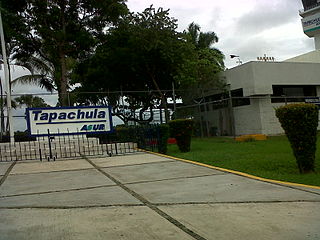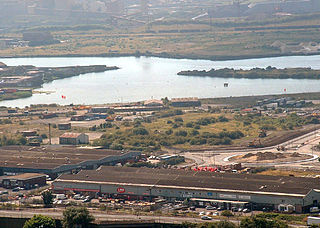
Colima is a city that is the capital of the Colima state and the seat of Colima municipality, located in central−western Mexico. It is located near the Colima volcano, which divides the small state from that of Jalisco.

Colima, officially the Free and Sovereign State of Colima, is one of the 31 states that make up the 32 Federal Entities of Mexico. It shares its name with its capital and main city, Colima.

Manzanillo is a city and seat of Manzanillo Municipality, in the Mexican state of Colima. The city, located on the Pacific Ocean, contains Mexico's busiest port, responsible for handling Pacific cargo for the Mexico City area. It is the largest-producing municipality for the business sector and tourism in the small state of Colima.

Bahías de Huatulco International Airport is an international airport located at Huatulco, in the state of Oaxaca, Mexico. The airport handles national and international air traffic for the southern and southeastern Pacific coast of Oaxaca state.

Tapachula International Airport, Aeropuerto Internacional de Tapachula, is an international airport located at Tapachula, Chiapas, is Mexico's southernmost airport. It handles national and international air traffic for the city of Tapachula, Port of Chiapas and the Soconusco region.
International Container Terminal Services, Inc. (ICTSI) is a global port management company headquartered in Manila, Philippines. Established on December 24, 1987, ICTSI is the Philippines' largest multinational and transnational company, having established operations in both developed and emerging market economies in Asia Pacific, the Americas, and Europe, the Middle East and Africa. The company is ranked the eighth largest container terminal operator, according to TEU equity volume.

Federal Highway 15 is Mexico 15 International Highway or Mexico-Nogales Highway, is a primary north-south highway, and is a free part of the federal highways corridors of Mexico. The highway begins in the north at the Mexico–United States border at the Nogales Port of Entry in Nogales, Sonora, and terminates to the south in Mexico City.

The port of Port Talbot is located on the River Afan estuary next to Port Talbot Steelworks in the industrial town of Port Talbot, South Wales. The whole basin complex covers about 500 acres (2.0 km2), consisting of: an inner set of floating docks, developed from 1834 onwards; and an outer tidal basin, completed in 1970. Owned and operated by Associated British Ports, the tidal basin has the deepest berthing facilities in the Severn estuary and is one of only a few harbours in the UK capable of handling Capesize vessels of up to 170,000 tonnes deadweight (DWT), mostly for the import of iron ore and coal for use by nearby Port Talbot Steelworks.

Querétaro Intercontinental Airport is an international airport located in the municipalities of Colón and El Marqués, Querétaro, Mexico. It handles the national and international air traffic of the city of Querétaro and can also be used as an alternate airport to Mexico City International Airport.
Federal Highway 2 is a free part of the Mexican federal highway corridors that runs along the U.S. border. The highway is in two separate improved segments, starting in the west at Tijuana, Baja California, on the Pacific coast and ending in the east in Matamoros, Tamaulipas, on the Gulf of Mexico. Fed. 2 passes through the border states of Baja California, Sonora, Chihuahua, Coahuila, Nuevo Leon and Tamaulipas. It has a total length of 1,963 kilometres (1,220 mi); 1,319 kilometres (820 mi) in the west and 644 kilometres (400 mi) in the east.

As the third largest and second most populous country in Latin America, Mexico has developed an extensive transportation network to meet the needs of the economy. As with communications, transportation in Mexico is regulated by the Secretariat of Communications and Transportation, a federal executive cabinet branch.

Federal Highway 54 Fed. 54 is a free (libre) part of the federal highways corridors and connects Ciudad Mier, Tamaulipas, to Colima City.
Federal Highway 80 connects Tampico, Tamaulipas, to San Patricio, Jalisco. Federal Highway 80 connects the city of Guadalajara to the south coast in Jalisco. The highway runs through the towns of Acatlán de Juárez, Villa Corona, Cocula, Tecolotlán, Unión de Tula, Autlán, La Huerta, Casimiro Castillo, and San Patricio (Melaque).
Federal Highway 3 is a tollfree part of the federal highway corridors. One segment connects Tecate to Ensenada in Baja California. This segment ends at its junction with Fed. 1 at El Sauzal Rodriguez, just a little north of Ensenada. This segment of the highway is 112 kilometers (70 mi) long.
Federal Highway 57 (Fed. 57) is a free (libre) part of the federal highways corridors of Mexico.
Federal Highway 98 is a Federal Highway of Mexico. The highway travels from Minatitlán, Colima in the northeast to Pez Vela Junction, Colima to the southwest. From Minatitlán, the highway continues on as a Colima state route to Colima City.
Federal Highway 110 is a Federal Highway of Mexico.
Federal Highway 200, also known as Carretera Pacífico, is a Federal Highway of Mexico. The Carretera Pacífico is the main leg of the Pacific Coastal Highway within Mexico and travels along the Pacific Coast from Mexican Federal Highway 15 in Tepic, Nayarit in the north to the Guatemala-Mexico border at Talismán, Chiapas in the south. Upon entering Guatemala, the highway continues as Central American Highway 1.
Federal Highway 225 is a Federal Highway of Mexico. It runs from Port Chiapas on the Pacific Ocean to the city of Tapachula, Chiapas.

Costa Azul LNG is sea port and natural gas processing center, located 15 miles north of Ensenada, Baja California, Mexico. Opened in 2008, the terminal can process, regasification, up to one billion cubic feet of natural gas per day. This is the first liquefied natural gas (LNG) terminal on the North America west coast. LNG carrier ships capable of holding up to 220,000m3 of LNG can dock in the deep water port off the coast to unload LNG. The natural gas from the terminal is used to produce electricity and is fed by pipe lines to factories. The longest pipeline runs north, to the United States. Sempra Energy is a partner in the port with PEMEX. The LNG ship Al Safliya was the first ship to port and unload at Costa Azul. The Al Safliya is a 210,000 cubic meter LNG ship, its LNG was from Qatar. The other Mexican LNG Terminal in the Pacific Ocean is at Manzanillo, Colima, the Manzanillo LNG Terminal.












